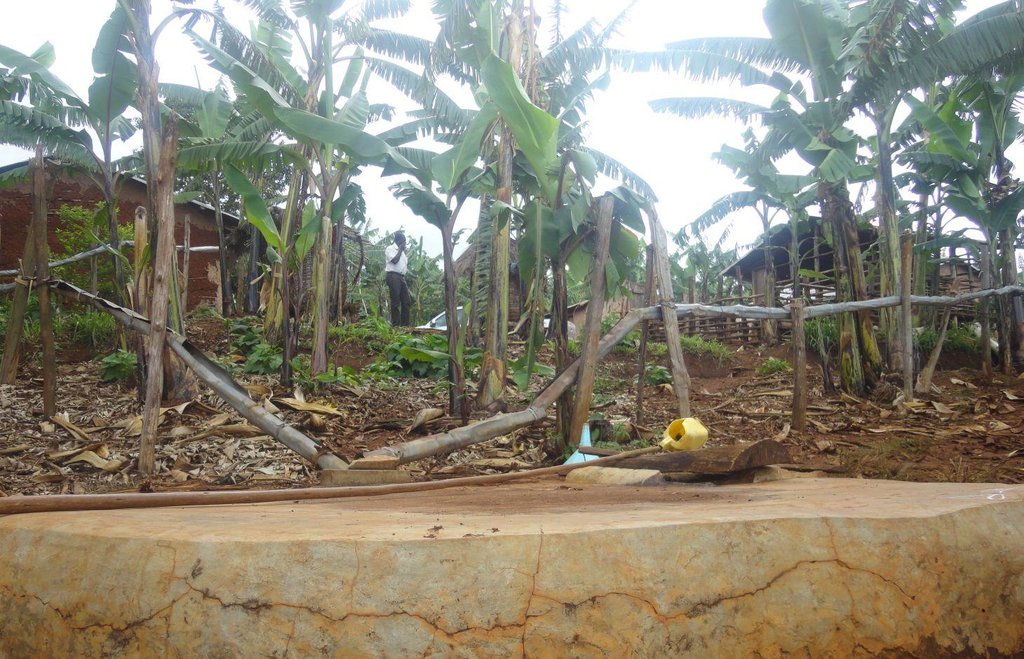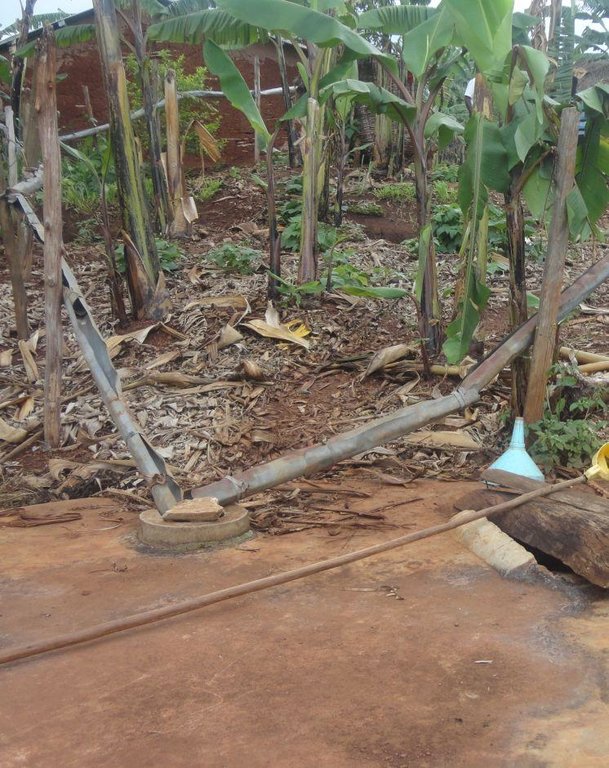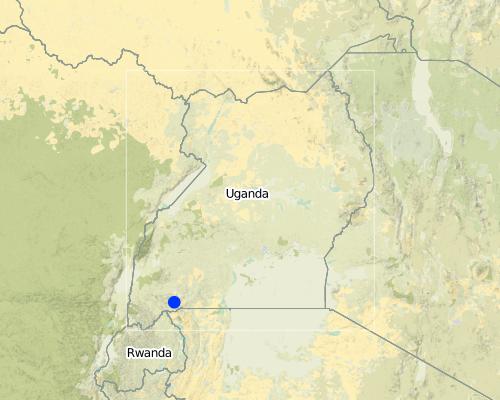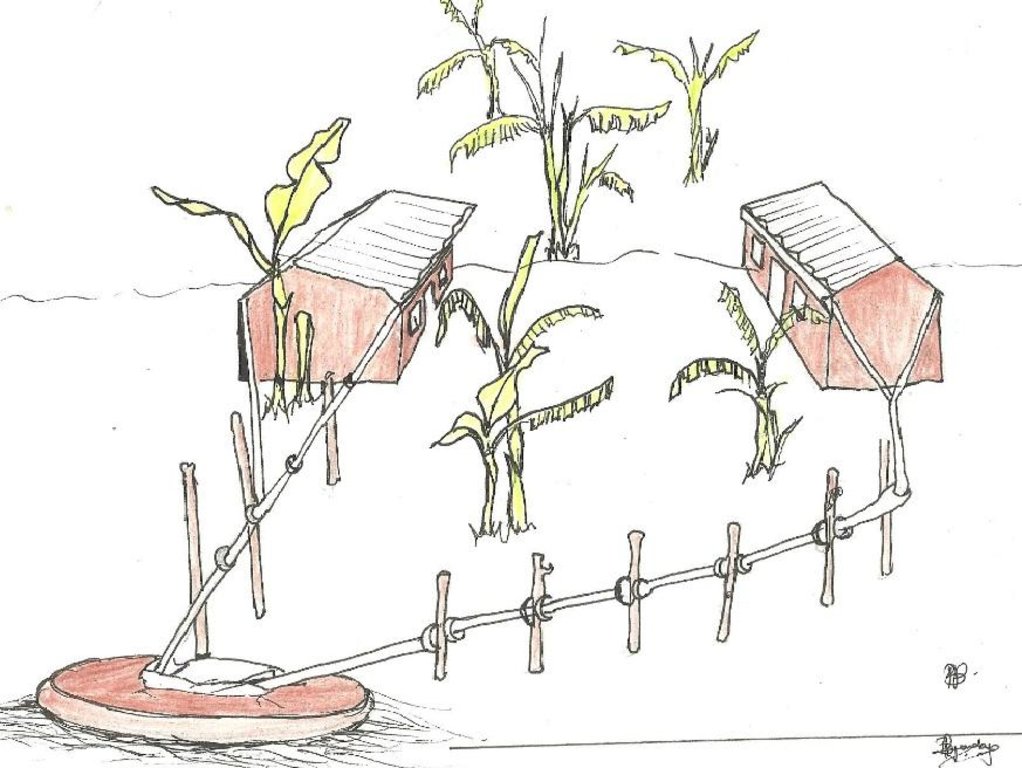Rubagano rooftop rainwater harvesting system (with concrete/brick tank) [Ouganda]
- Création :
- Mise à jour :
- Compilateur : Wilson Bamwerinde
- Rédacteur : –
- Examinateur : Fabian Ottiger
Okwombeka tanka z'amaizi ahamaju (Runyankore)
technologies_1595 - Ouganda
Voir les sections
Développer tout Réduire tout1. Informations générales
1.2 Coordonnées des personnes-ressources et des institutions impliquées dans l'évaluation et la documentation de la Technologie
Spécialiste GDT:
Spécialiste GDT:
Nom du projet qui a facilité la documentation/ l'évaluation de la Technologie (si pertinent)
The Transboundary Agro-ecosystem Management Project for the Kagera River Basin (GEF-FAO / Kagera TAMP )Nom du ou des institutions qui ont facilité la documentation/ l'évaluation de la Technologie (si pertinent)
Food and Agriculture Organization of the United Nations (FAO) - Italie1.3 Conditions relatives à l'utilisation par WOCAT des données documentées
Quand les données ont-elles été compilées (sur le terrain)?
05/12/2013
Le compilateur et la(les) personne(s) ressource(s) acceptent les conditions relatives à l'utilisation par WOCAT des données documentées:
Oui
2. Description de la Technologie de GDT
2.1 Courte description de la Technologie
Définition de la Technologie:
Rain-water from all corrugated iron roof structures in one compound is harvested and stored in underground tanks.
2.2 Description détaillée de la Technologie
Description:
Despite high precipitation (>1200 mm), Rubagano still experiences water shortage. It is hilly, with steep (>30%) to very steep (>58%) slopes. Rain water runs off to the valleys below, causing erosion and damaging infrastructure such as roads along its course. There is little rain water infiltration and the ground water level low. The few boreholes that government constructed in the area are often dry. Therefore women and children normally walk distances of up to 4 km to fetch water which, in many cases, is actually runoff dammed behind a concrete wall built across an open rock patch. To alleviate water scarcity, farmers have been mobilized by Kagera TAMP project to harvest the rain water from their own roofs. Because water sources are far from most households, rooftop water harvesting has a very high utility for the farmers. Adoption is high.
Purpose of the Technology: The primary goal of the technology is to increase household water availability. It also reduces runoff, produces water for the tree nursery and backyard gardens..
Establishment / maintenance activities and inputs: Requirements for harvesting water on an iron roof are water collection gutters and an underground tank. Rain falling on the roof flows into collection gutters constructed around the roof which angle gently away from the house and end at one or more underground tanks. Excavation and construction of the storage tank is costly and requires well qualified artisans. These are trained locally and are available within the community to minimize costs. The underground tank is constructed by excavating the ground between 3.0 m and 3.5 m deep and 2.0 m to 2.5 m diameter. Thus, a small tank will have a capacity of 38,000 litres (38 cubic metres). The bottom and walls of the pit is then built up throughout with brick and mortar. The top is a concrete slab with 2 openings of 0.3 m diameter, one connected to the gutters and the other through which a plastic container is lowered to fetch water. Though establishment costs appear high for farmers, the longer term benefits outweigh the original cost. Once established the maintenance costs are limited to periodic cleaning.
Natural / human environment: Heavy rainstorms may blow the gutters out of position.
2.3 Photos de la Technologie
2.5 Pays/ région/ lieux où la Technologie a été appliquée et qui sont couverts par cette évaluation
Pays:
Ouganda
Région/ Etat/ Province:
Uganda
Autres spécifications du lieu:
Mbarara District (Rubagano, Mwizi)
Commentaires:
Boundary points of the Technology area: -0.85203 30.62232; -0.85850 30.62204; -0.85792 30.62021
Map
×2.6 Date de mise en œuvre de la Technologie
Si l'année précise est inconnue, indiquez la date approximative: :
- il y a moins de 10 ans (récemment)
2.7 Introduction de la Technologie
Spécifiez comment la Technologie a été introduite: :
- par le biais de projets/ d'interventions extérieures
3. Classification de la Technologie de GDT
3.1 Principal(aux) objectif(s) de la Technologie
- améliorer la production
- s'adapter au changement et aux extrêmes climatiques et à leurs impacts
3.2 Type(s) actuel(s) d'utilisation des terres, là où la Technologie est appliquée

Terres cultivées
- Cultures pérennes (non ligneuses)
- Plantations d’arbres ou de buissons
Principales cultures (vivrières et commerciales):
Major cash crop perennial (non-woody) cropping: Banana
Major food crop perennial (non-woody) cropping: Banana
Major cash crop tree and shrub cropping: Coffee

Voies d'eau, plans d'eau, zones humides
Commentaires:
Major land use problems (compiler’s opinion): Loss of vegetation, soil erosion and very low ground water level. Difficulty in finding access to water for domestic use, livestock and crop irrigation.
Major land use problems (land users’ perception): Women and children walk very long distances in search of water from permanent natural wells.
3.3 Informations complémentaires sur l'utilisation des terres
Approvisionnement en eau des terres sur lesquelles est appliquée la Technologie:
- pluvial
Précisez:
Longest growing period in days: 120 Longest growing period from month to month: September to December Second longest growing period in days: 90 Second longest growing period from month to month: February to May
3.4 Groupe de GDT auquel appartient la Technologie
- récupération/ collecte de l'eau
3.5 Diffusion de la Technologie
Commentaires:
Total area covered by the SLM Technology is 0.001 m2.
3.6 Mesures de GDT constituant la Technologie

structures physiques
- S5: Barrages/retenues, micro-bassins, étangs
Commentaires:
Main measures: structural measures
3.7 Principaux types de dégradation des terres traités par la Technologie

dégradation hydrique
- Hs: changement de la quantité d’eau de surface
- Hp: baisse de la qualité des eaux de surface
Commentaires:
Main type of degradation addressed: Hs: change in quantity of surface water, Hp: decline of surface water quality
Main causes of degradation: soil management (Removal of vegetation cover), deforestation / removal of natural vegetation (incl. forest fires) (Forests harvested for fuel wood, charcoal, agriculture etc.), other natural causes (avalanches, volcanic eruptions, mud flows, highly susceptible natural resources, extreme topography, etc.) specify (Steep slopes increase the speed of runoff and soil erosion)
Secondary causes of degradation: change of seasonal rainfall (Climate change effects of human activity), droughts (Longer dry spells as a result of climatic changes), poverty / wealth (Cannot afford manure or fertilizers to make soil more productive so forest is cut to create more agricultural land)
3.8 Prévention, réduction de la dégradation ou réhabilitation des terres dégradées
Spécifiez l'objectif de la Technologie au regard de la dégradation des terres:
- réduire la dégradation des terres
4. Spécifications techniques, activités, intrants et coûts de mise en œuvre
4.1 Dessin technique de la Technologie
4.2 Spécification/ explications techniques du dessin technique
Details of rainwater harvesting system: roof catchment, gutters and underground storage tank
Location: Rubagano, Mwizi Sub-county, Mbarara District. Uganda
Date: 18 December 2013
Technical knowledge required for field staff / advisors: moderate
Technical knowledge required for land users: low (Artisan's work once the land user has decided on the size of the water tank required)
Main technical functions: water harvesting / increase water supply
Secondary technical functions: control of dispersed runoff: retain / trap, control of concentrated runoff: drain / divert, water spreading
Dam/ pan/ pond
Depth of ditches/pits/dams (m): d=3.0
Width of ditches/pits/dams (m): r=2.0
Length of ditches/pits/dams (m): n/a
Specification of dams/ pans/ ponds: Capacity 38m3
Catchment area: 900 m2m2
Beneficial area: 900 m2m2
For water harvesting: the ratio between the area where the harvested water is applied and the total area from which water is collected is: 1:0.1
4.3 Informations générales sur le calcul des intrants et des coûts
autre/ monnaie nationale (précisez):
UGX
Indiquer le taux de change du dollars en monnaie locale (si pertinent): 1 USD= :
2500,0
Indiquez le coût salarial moyen de la main d'œuvre par jour:
10.00
4.4 Activités de mise en place/ d'établissement
| Activité | Type de mesures | Calendrier | |
|---|---|---|---|
| 1. | Tank construction | Structurel | Throughout the year |
| 2. | Procurement and raising of collection gutters | Structurel | Throughout the year |
| 3. | Wooden poles | Structurel | Throughout the year |
4.5 Coûts et intrants nécessaires à la mise en place
| Spécifiez les intrants | Unité | Quantité | Coûts par unité | Coût total par intrant | % des coût supporté par les exploitants des terres | |
|---|---|---|---|---|---|---|
| Main d'œuvre | Labour | ha | 1,0 | 500,0 | 500,0 | 100,0 |
| Equipements | Tools | ha | 1,0 | 30,0 | 30,0 | 100,0 |
| Matériaux de construction | Wood | ha | 1,0 | 16,0 | 16,0 | 100,0 |
| Matériaux de construction | Bricks | ha | 1,0 | 400,0 | 400,0 | 100,0 |
| Matériaux de construction | Cement | ha | 1,0 | 420,0 | 420,0 | 100,0 |
| Matériaux de construction | Sand | ha | 1,0 | 160,0 | 160,0 | 100,0 |
| Coût total de mise en place de la Technologie | 1526,0 | |||||
Commentaires:
Duration of establishment phase: 2 month(s)
4.6 Activités d'entretien/ récurrentes
| Activité | Type de mesures | Calendrier/ fréquence | |
|---|---|---|---|
| 1. | Tank maintenance (above ground) | Structurel | Once a year |
| 2. | Gutter replacement | Structurel | Twice a year |
| 3. | Wooden poles | Structurel | Twice a year |
4.7 Coûts et intrants nécessaires aux activités d'entretien/ récurrentes (par an)
| Spécifiez les intrants | Unité | Quantité | Coûts par unité | Coût total par intrant | % des coût supporté par les exploitants des terres | |
|---|---|---|---|---|---|---|
| Main d'œuvre | Labour | ha | 1,0 | 80,0 | 80,0 | 100,0 |
| Equipements | Tools | ha | 1,0 | 10,0 | 10,0 | 100,0 |
| Matériaux de construction | Wood | ha | 1,0 | 4,0 | 4,0 | 100,0 |
| Matériaux de construction | Bricks | ha | 1,0 | 40,0 | 40,0 | 100,0 |
| Matériaux de construction | Cement | ha | 1,0 | 42,0 | 42,0 | 100,0 |
| Matériaux de construction | Sand | ha | 1,0 | 40,0 | 40,0 | 100,0 |
| Coût total d'entretien de la Technologie | 216,0 | |||||
Commentaires:
Machinery/ tools: Pick-axe, hand hoe, panga
The calculations were done for a 38.0 cubic meter tank constructed in September 2013
4.8 Facteurs les plus importants affectant les coûts
Décrivez les facteurs les plus importants affectant les coûts :
Skilled labor for the construction of the underground tank
5. Environnement naturel et humain
5.1 Climat
Précipitations annuelles
- < 250 mm
- 251-500 mm
- 501-750 mm
- 751-1000 mm
- 1001-1500 mm
- 1501-2000 mm
- 2001-3000 mm
- 3001-4000 mm
- > 4000 mm
Spécifications/ commentaires sur les précipitations:
Average annual rainfall for Rubagano is >1200 mm
Zone agro-climatique
- subhumide
Thermal climate class: tropics
5.2 Topographie
Pentes moyennes:
- plat (0-2 %)
- faible (3-5%)
- modéré (6-10%)
- onduleux (11-15%)
- vallonné (16-30%)
- raide (31-60%)
- très raide (>60%)
Reliefs:
- plateaux/ plaines
- crêtes
- flancs/ pentes de montagne
- flancs/ pentes de colline
- piémonts/ glacis (bas de pente)
- fonds de vallée/bas-fonds
Zones altitudinales:
- 0-100 m
- 101-500 m
- 501-1000 m
- 1001-1500 m
- 1501-2000 m
- 2001-2500 m
- 2501-3000 m
- 3001-4000 m
- > 4000 m
Commentaires et précisions supplémentaires sur la topographie:
Altitudinal zone: 1501-2000 m a.s.l (Ranked 1, rubagano has an average altitude of 1700 m a.s.l) and 1001-1500 m a.s.l. (ranked 2)
5.3 Sols
Profondeur moyenne du sol:
- très superficiel (0-20 cm)
- superficiel (21-50 cm)
- modérément profond (51-80 cm)
- profond (81-120 cm)
- très profond (>120 cm)
Texture du sol (de la couche arable):
- moyen (limoneux)
Matière organique de la couche arable:
- faible (<1%)
Si disponible, joignez une description complète du sol ou précisez les informations disponibles, par ex., type de sol, pH/ acidité du sol, capacité d'échange cationique, azote, salinité, etc.
Soil fertility: Low (ranked 1) and medium (ranked 2)
Soil drainage/infiltration: Medium
Soil water storage capacity: Medium (ranked 1) and low (ranked 2)
5.4 Disponibilité et qualité de l'eau
Profondeur estimée de l’eau dans le sol:
> 50 m
Disponibilité de l’eau de surface:
faible/ absente
Qualité de l’eau (non traitée):
faiblement potable (traitement nécessaire)
5.5 Biodiversité
Diversité des espèces:
- faible
5.6 Caractéristiques des exploitants des terres appliquant la Technologie
Orientation du système de production:
- subsistance (auto-approvisionnement)
- mixte (de subsistance/ commercial)
Revenus hors exploitation:
- moins de 10% de tous les revenus
Niveau relatif de richesse:
- moyen
Individus ou groupes:
- individu/ ménage
Niveau de mécanisation:
- travail manuel
Genre:
- femmes
- hommes
Indiquez toute autre caractéristique pertinente des exploitants des terres:
Land users applying the Technology are mainly common / average land users
Population density: 50-100 persons/km2
Annual population growth: 2% - 3%
1% of the land users are very rich and own 10% of the land.
15% of the land users are rich and own 20% of the land.
80% of the land users are average wealthy and own 65% of the land (Have an iron roof house, some livestock and land for cultivation).
4% of the land users are poor and own 5% of the land.
Off-farm income specification: Similar statistics for all types of land users as far as off-farm income is concerned
Level of mechanization: Manual work (All land is cultivated manually)
Market orientation of production system: Mixed (ranked 1, most farmers cultivate banana plantations for subsistence and commercial use) and subsistence (ranked 2, a few farmers cultivate for subsisce)
5.7 Superficie moyenne des terres détenues ou louées par les exploitants appliquant la Technologie
- < 0,5 ha
- 0,5-1 ha
- 1-2 ha
- 2-5 ha
- 5-15 ha
- 15-50 ha
- 50-100 ha
- 100-500 ha
- 500-1 000 ha
- 1 000-10 000 ha
- > 10 000 ha
Cette superficie est-elle considérée comme de petite, moyenne ou grande dimension (en se référant au contexte local)?
- petite dimension
5.8 Propriété foncière, droits d’utilisation des terres et de l'eau
Propriété foncière:
- individu, sans titre de propriété
Droits d’utilisation des terres:
- individuel
Droits d’utilisation de l’eau:
- accès libre (non organisé)
5.9 Accès aux services et aux infrastructures
santé:
- pauvre
- modéré
- bonne
éducation:
- pauvre
- modéré
- bonne
assistance technique:
- pauvre
- modéré
- bonne
emploi (par ex. hors exploitation):
- pauvre
- modéré
- bonne
marchés:
- pauvre
- modéré
- bonne
énergie:
- pauvre
- modéré
- bonne
routes et transports:
- pauvre
- modéré
- bonne
eau potable et assainissement:
- pauvre
- modéré
- bonne
services financiers:
- pauvre
- modéré
- bonne
6. Impacts et conclusions
6.1 Impacts sur site que la Technologie a montrés
Impacts socio-économiques
Production
production agricole
production de bois
risque d'échec de la production
surface de production
Disponibilité et qualité de l'eau
disponibilité de l'eau potable
Revenus et coûts
dépenses pour les intrants agricoles
revenus agricoles
Impacts socioculturels
sécurité alimentaire/ autosuffisance
situation sanitaire
connaissances sur la GDT/ dégradation des terres
situation des groupes socialement et économiquement désavantagés
Commentaires/ spécifiez:
Women and children
Improved livelihoods and human well-being
Commentaires/ spécifiez:
Women and children no longer have to walk long distances in search of water.
Impacts écologiques
Cycle de l'eau/ ruissellement
quantité d'eau
qualité de l'eau
récolte/ collecte de l'eau
ruissellement de surface
évaporation
Sols
humidité du sol
Biodiversité: végétale, animale
diversité végétale
6.2 Impacts hors site que la Technologie a montrés
disponibilité de l'eau
inondations en aval
dommages sur les infrastructures publiques/ privées
Commentaires/ spécifiez:
E.g. Roads
6.3 Exposition et sensibilité de la Technologie aux changements progressifs et aux évènements extrêmes/catastrophes liés au climat (telles que perçues par les exploitants des terres)
Changements climatiques progressifs
Changements climatiques progressifs
| Saison | Type de changements/ extrêmes climatiques | Comment la Technologie fait-elle face à cela? | |
|---|---|---|---|
| températures annuelles | augmente | bien |
Extrêmes climatiques (catastrophes)
Catastrophes météorologiques
| Comment la Technologie fait-elle face à cela? | |
|---|---|
| pluie torrentielle locale | bien |
| tempête de vent locale | bien |
Catastrophes climatiques
| Comment la Technologie fait-elle face à cela? | |
|---|---|
| sécheresse | pas bien |
Catastrophes hydrologiques
| Comment la Technologie fait-elle face à cela? | |
|---|---|
| inondation générale (rivière) | bien |
Autres conséquences liées au climat
Autres conséquences liées au climat
| Comment la Technologie fait-elle face à cela? | |
|---|---|
| réduction de la période de croissance | bien |
6.4 Analyse coûts-bénéfices
Quels sont les bénéfices comparativement aux coûts de mise en place (du point de vue des exploitants des terres)?
Rentabilité à court terme:
négative
Rentabilité à long terme:
très positive
Quels sont les bénéfices comparativement aux coûts d'entretien récurrents (du point de vue des exploitants des terres)?
Rentabilité à court terme:
neutre / équilibrée
Rentabilité à long terme:
très positive
Commentaires:
The technology may appear expensive to the farmer at the time of establishment but it is cost-effective in the long-term.
6.5 Adoption de la Technologie
Si disponible, quantifiez (nombre de ménages et/ou superficie couverte):
25
Parmi tous ceux qui ont adopté la Technologie, combien d'entre eux l'ont fait spontanément, à savoir sans recevoir aucune incitation matérielle ou aucun paiement?
- 50-90%
Commentaires:
20% of land user families have adopted the Technology with external material support
5 land user families have adopted the Technology with external material support
80% of land user families have adopted the Technology without any external material support
20 land user families have adopted the Technology without any external material support
There is a moderate trend towards spontaneous adoption of the Technology
Comments on adoption trend: Regardless of the high costs involved, improved water security has encouraged farmers to adapt the technology.
6.7 Points forts/ avantages/ possibilités de la Technologie
| Points forts/ avantages/ possibilités du point de vue du compilateur ou d'une autre personne ressource clé |
|---|
|
Makes water for drinking and domestic use more readily available to the household How can they be sustained / enhanced? Encourage adoption and maintenance through farmer-to-farmer information |
|
Saves women and children from walking long distances in search of clean water How can they be sustained / enhanced? Empower women and children to demand and obtain rooftop water harvesting at home |
|
Rooftop harvested water is cleaner than trapped runoff used by many members of the community How can they be sustained / enhanced? Help households to acquire materials for rooftop water harvesting |
6.8 Faiblesses/ inconvénients/ risques de la Technologie et moyens de les surmonter
| Faiblesses/ inconvénients/ risques du point de vue du compilateur ou d'une autre personne ressource clé | Comment peuvent-ils être surmontés? |
|---|---|
| Technology is expensive to establish | Support government and private sector to subsidize tanking systems for farmers |
| Requires technical expertise especially in concrete preparation to prevent cracks and leakages | Ensure farmers who express the need to adapt get access to construction technicians |
7. Références et liens
7.2 Références des publications disponibles
Titre, auteur, année, ISBN:
Kagera TAMP project website
Disponible à partir d'où? Coût?
www.fao.org/nr/kagera/en
Liens et modules
Développer tout Réduire toutLiens
Aucun lien
Modules
Aucun module trouvé






